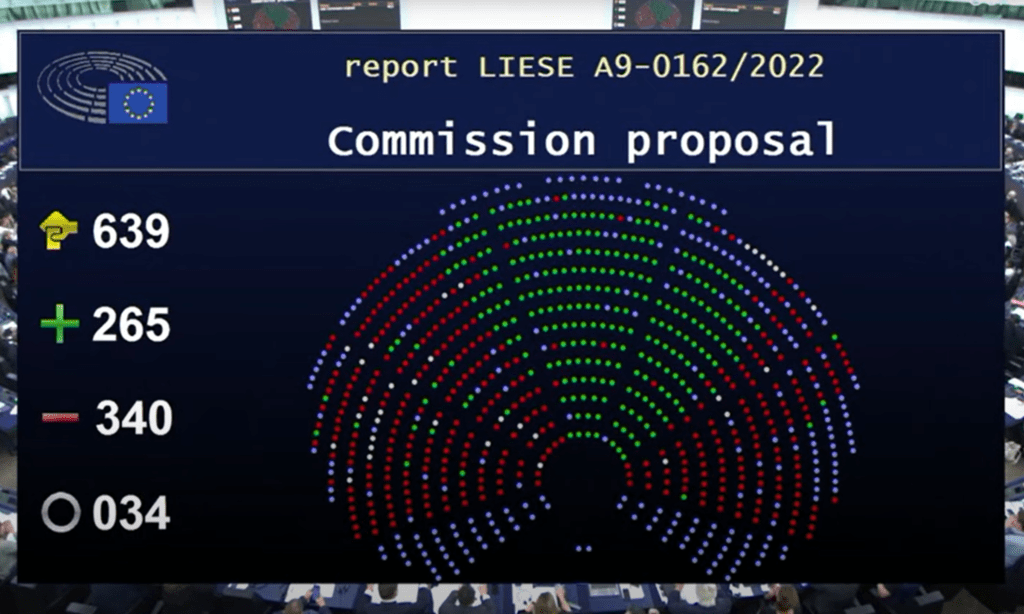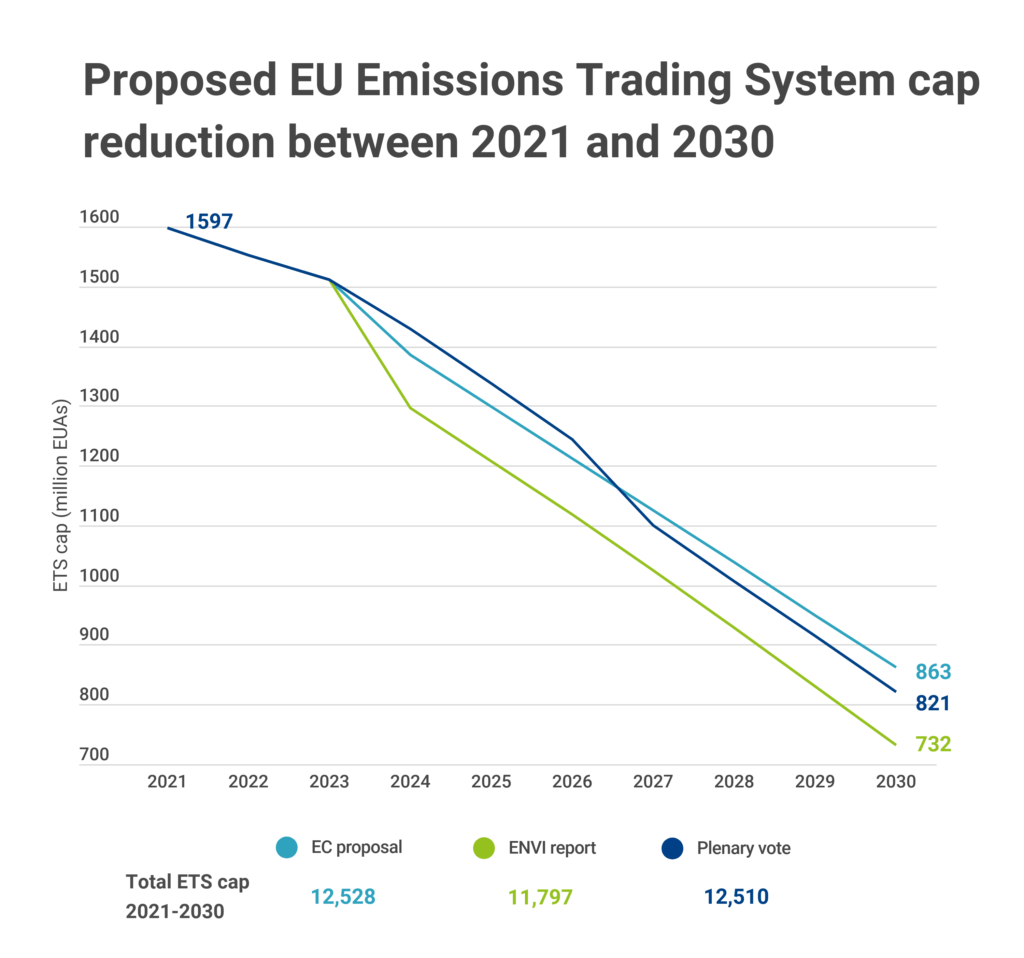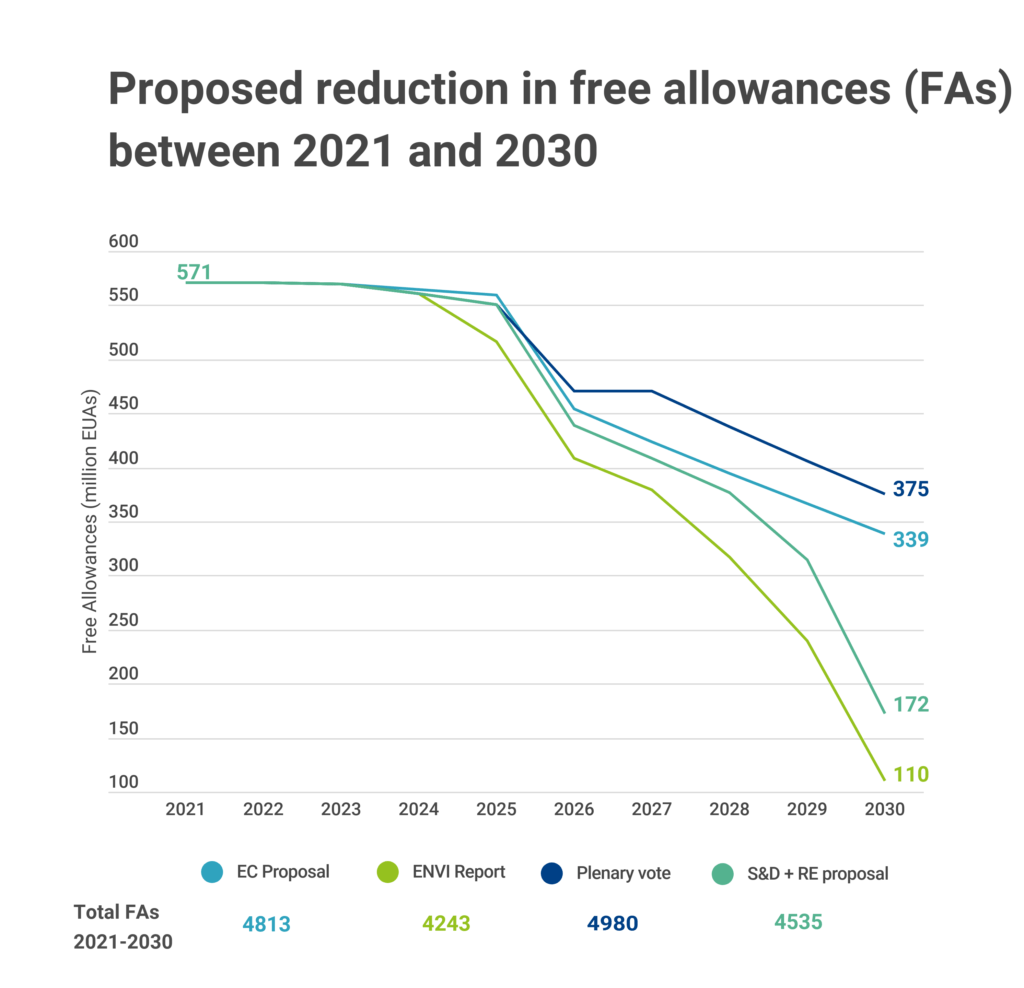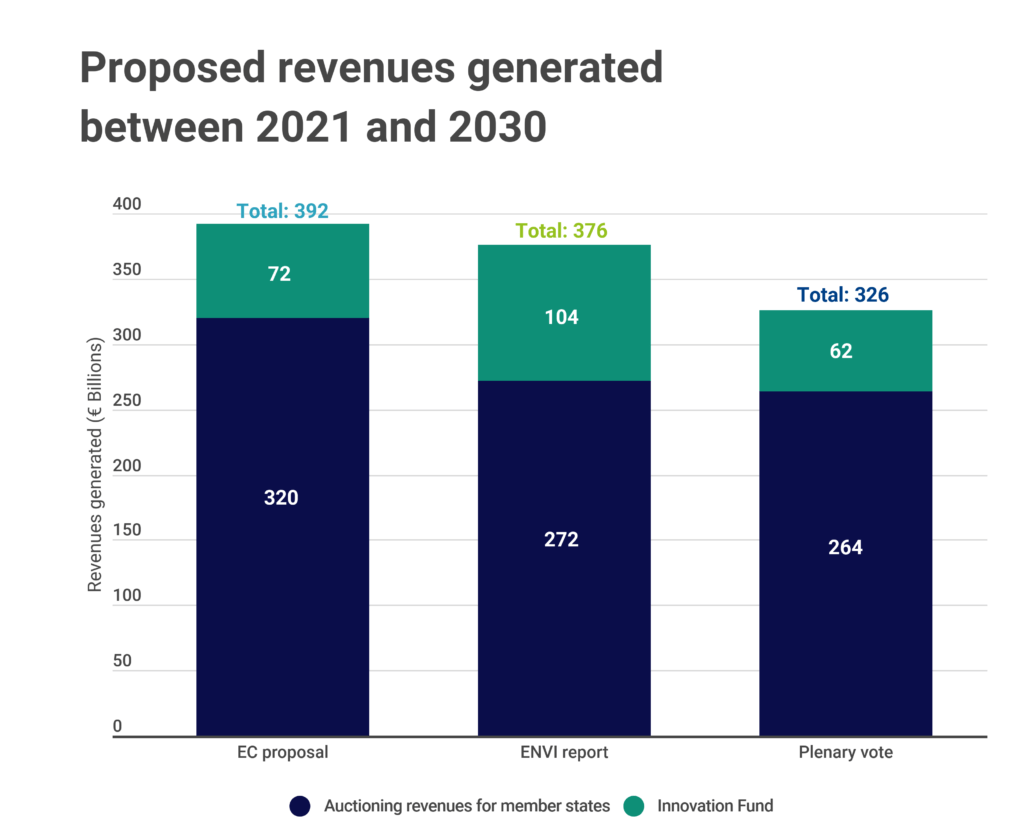
Since the European Parliament’s failure to reach an agreement on the comprehensive reform of the EU Emissions Trading System, MEPs have traded recriminations. However, those claiming that the defeated compromise deal was good for the climate are being disingenuous. Our analysis reveals it would have been catastrophic had it gone through.
On 8 June 2022, the European Parliament voted on the reform of the EU carbon market but ultimately failed to reach an agreement. A majority of MEPs voted against a deal that included eleventh-hour compromises that watered down the package’s environmental integrity, and referred the file back to the parliament’s Environment Committee.
After the fact, some MEPs and media outlets described the parliament’s move as an attempt to kill a deal that would have been very good for the climate and would have bolstered industrial transformation.
But how good was the deal in reality? What would have been its impact had it made it all the way through the legislative process? To answer these questions, we, at Carbon Market Watch, crunched the numbers using a model developed by Climact.
Ceilings and freebies
The legislative process for reviewing the complex legislation underpinning the EU Emissions Trading System, the ETS Directive, has been notoriously long and contentious, since it involved an initial European Commission proposal and hundreds of subsequent proposed amendments which had to be voted on.
The most contentious points on the reform of the EU ETS, were the 2030 emission reduction target for ETS sectors (i.e. how rapidly the emissions cap or ceiling would be lowered) and the timeline to phase out free pollution permits to heavy industry (i.e. how much longer polluters would be exempted from paying for the cost of their pollution), in combination with the introduction of the new Carbon Border Adjustment Mechanism (CBAM).
Several different options, leading to different outcomes, were on the menu for the plenary and they all had to be voted on, from the most ambitious to the least ambitious one.
Overview of amendments on ETS climate target
On 17 May, the ENVI committee voted for an emission reduction target of 68% by 2030 and a phase out of free pollution permits by the same year.
Almost all other options brought to the table before plenary were watered-down versions of this agreement.
A deal tabled jointly by the centre-right EPP and the liberal Renew aimed to lower the target to 64% by only partially addressing the oversupply of emission allowances, one of the biggest weaknesses of the EU carbon market.
| Most ambitious proposal | 75% emissions reduction |
| ENVI report | 68% emissions reduction, partly addresses oversupply |
| Alternative amendment | 64% emissions reduction, fails to properly address oversupply risking to not meet the target in the end |
| Least ambitious proposal | 64% emissions reduction, ignores the oversupply problem |

Analysing the numbers in more detail, it becomes clear that compared to the ENVI outcome, the deal voted out at the ETS plenary deal would have allowed for more than 700 million tonnes of extra greenhouse gas pollution. This is more than the total annual emissions of Italy, Spain and Romania combined. Such an outcome in the EP plenary would have failed any professed climate ambition. It would have been mostly a great deal for heavy industry, who would have been once again entirely shielded from any responsibility towards the climate.
CBAM and free pollution permits
One of the most controversial topics of the EU ETS reform, the phase-out of free pollution permits proved to be a tougher deal to strike.
The ENVI Committee managed to find an agreement among more progressive MEPs to gradually reduce free pollution permits to zero by 2030 and, thereby, significantly increase the financial resources for the Innovation Fund.
Ahead of the plenary vote, the centre-left S&D group put forward an alternative proposal in a bid to secure the support of MEPs and groups that considered the ENVI proposal too ambitious. This deal would have extended free permits to 2032, therefore adding some delay and reducing the size of the Innovation Fund but was still more ambitious than the Commission’s original proposal. It would have led to fewer free pollution permits and more revenue for the Innovation Fund.
One more proposal was also put forward that significantly watered down the ENVI report and was ultimately even worse than the Commission’s proposal.
This amendment originated in the European Parliament’s opinion-giving industry, research and energy committee (ITRE) and was retabled by some MEPs before the plenary vote. As shown in the graph below, this proposal would slow down the phase out of free pollution permits and extend them well beyond 2030, leading to large amounts of free allowances for industry and very little money left over for the Innovation Fund.
This very proposal was the one that received support by a majority of MEPs before the whole deal was ultimately rejected.

The ‘would have been’ outcome
Most of the MEPs that pulled the plug on the deal did so based on the conclusion that, if voted through, the overall outcome would have been disastrous for the climate.
As shown in the table below, the plenary vote would have led to a lower cut in greenhouse gas emissions, lower auctioning revenues for member states to reinvest in climate action, lower resources for the Innovation Fund, which supports industrial decarbonisation, and a higher supply of free pollution permits, which are a known disincentive for investments in clean technologies.
| Volume = million ETS allowances (2021-2030) | European Commission’s proposal | ENVI report | Plenary vote (08/06) |
| 2030 emission reduction | 61% | 68% | 64% |
| Total ETS allowances | 12,527 | 11,795 | 12,509 |
| Of which: member states auctioned allowances | 4032 | 3410 | 3310 |
| And: free allocation | 4813 | 4243 | 4980* |
| Total volume Innovation Fund/ Climate Investment Fund | 899 | 1305 | 770* |
The biggest losers in this deal would have been the climate, EU taxpayers and the Innovation Fund.
Indeed, the plenary vote would have secured almost 5 billion free pollution permits for energy-intensive industries such as steel, cement and chemicals (the power sector does not receive free permits anymore). At €80EUR per tonne, this amounts to €400 billion of lost revenues that member states could instead have pumped into climate-friendly investments, including supporting heavy industry to embark on a green transition.
The ENVI compromise, although not ambitious enough, reduces free permits gradually over the next eight years and puts a firm end to them in 2030, providing strong predictability and an invaluable opportunity for companies to scale up their investments in clean production processes.

By auctioning, instead of giving away, ETS emission allowances, member states raise significant amounts of money from the EU carbon market that they can reinvest into a whole host of other measures to bolster the green transition.
The watered-down proposal defeated at the plenary would have, instead, reduced the volume of revenue generated through auctioning, mainly due to the massive amounts of free allowances to heavy polluters. As shown in the table above, only a little over 3.3 billion allowances would have become shared revenue among 27 member states, while almost 5 billion would have been given away for free.

For all the talk about the critical need to support innovative clean technologies, the EP vote would have almost halved the resources dedicated to the financial instrument tasked with that mission, the Innovation Fund. Since most revenues for this fund are generated through the phase out of free pollution permits, the slower these freebies are abolished, the smaller the resources available for innovation. It’s simple maths and there is no way around it.
In contrast, the ENVI deal greatly increased the capacity of the Innovation Fund and had the ambition to widen its scope to also support the widespread adoption of existing technologies and business models to get on the market. With a firm end to free pollution permits and increasing auctioning revenues, this proposal would make 1.3 billion allowances available to the Innovation Fund (more than €100 billion for the next eight years).
New deal like the old deal
Centre-left S&D, centre-right EPP and liberal Renew MEPs publicly claimed on Wednesday 15 June that they had reached a new deal on ETS reform that was an improvement on the compromise rejected at the plenary vote. To fact check this claim, we again ran our model and discovered that this could not be further from the truth. It is really not such a big improvement. It is basically no improvement at all.
The new proposal, which keeps the one-off reduction of the overall ETS cap as voted in plenary and increases the yearly reduction of the cap a bit more in 2029, would see an overall emission reduction in 2030 that is merely 23 megatonnes lower than what was voted in plenary last week. This is equivalent to the annual emissions of just four steel plants.

Moreover, the slower phase-out of free allowances, starting in 2027 means that this new proposal will largely have the same effect as the Commission’s proposal: copious amounts of free allowances to large polluters until 2030 (almost 5 billion like in the plenary vote).

The new proposal, like the plenary vote, also generates lower revenue for member states and for investment in innovation.

Conclusion
Following this thorough assessment, we conclude that no deal was better than a bad deal. The climate crisis calls for swift action and ambitious targets, not more delays and a new blank cheque for heavy industry to pollute with impunity.
Based on our analysis, the compromise that was shot down was not simply a matter of a couple of irrelevant percentage points or a couple of inconsequential years, as some are claiming. In reality, the deal would have delivered a terrible outcome for the climate, the negative fallout of which would stretch many years into the future, undermining the EU’s ability to reach its vital 2030 interim targets.
The European Parliament is now scheduled to vote again on EU ETS reform, this time in Brussels instead of Strasbourg, on 22 June.
It must find a way to agree to an ambitious revision of the EU ETS in order to raise the bar for interinstitutional negotiations with the Council of the European Union and the European Commission. This was not achieved with the draft new deal agreed on Wednesday 15 June. This was almost a carbon copy of the rejected compromise deal that does very little to reduce European industry’s carbon footprint. This deal fails to do what is required and so MEPs must come up with a better solution next week.
This is a precious opportunity that Europe cannot afford to waste. The climate crisis will not take a holiday while we get our house in order. And the longer we take a leave of responsibility, the worse the effects of climate breakdown will be on humanity and life on Earth. MEPs must act now.
_____
Note: This article was updated on 15 June 2022 to reflect a proposed new deal agreed by three political groups in the European Parliament.
Author
-

Agnese was Carbon Market Watch's policy lead on the EU carbon market and industrial decarbonisation.
View all posts






